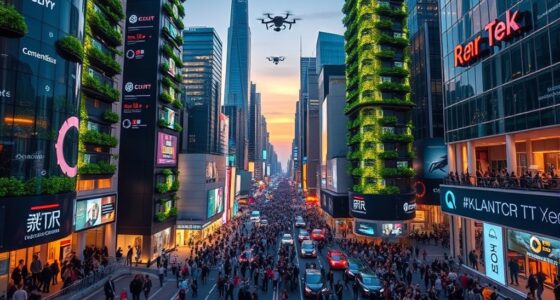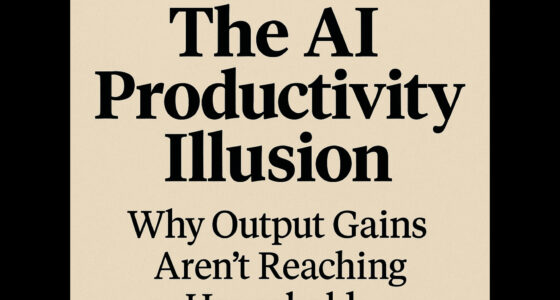Post‑Labor Economics Series
By Thorsten Meyer — June 2025
Executive takeaway
The slice of national income flowing to workers is nearing record lows just as generative AI enters hyper‑adoption. Global labour’s share of GDP fell to 52.3 % in 2022, extending a two‑decade slide, and has not bounced back during the post‑pandemic recovery. Unless policy and corporate practice shift quickly, the gains from the AI boom will concentrate even more heavily in corporate profits and intangible capital, threatening aggregate demand and social consent for continued automation.
1 | How far has labour’s slice shrunk?
| Jurisdiction | Latest reading | 2000s peak | Change |
| World (ILO) | 52.3 % (2022) | 55.0 % (2004) | ‑2.7 pp |
| United States (BLS index, 2017 = 100) | 97.7 (Q1 2025) ≈ 51.7 % of GDP | 103.2 (2001) | –5.5 % |
| EU‑27 (Eurostat) | 47.9 % (2024) | 50.4 % (2001) | –2.5 pp |
Unlike earlier technology cycles, the current downturn in labour share spans both manufacturing and service economies, suggesting a pervasive structural force rather than a sector‑specific shock.
2 | Technology’s imprint on the decline
| Evidence | Key finding |
| AI‑patent intensity (1 609 EU regions, 1995‑2022) | Doubling AI patents cuts labour share 0.5–1.6 pp. |
| Philadelphia Fed (Q1 2024) | Generative AI could unleash a “once‑in‑a‑lifetime downward shock” to labour income. |
| IMF jobs‑exposure model (2024) | 40 % of global jobs—and 60 % in advanced economies—are AI‑exposed, signalling potential wage suppression on an unprecedented scale. |
Mechanisms now operate on both production lines and keyboards: task substitution, plummeting costs of capital equipment (robots & cloud GPUs), and winner‑takes‑most “superstar” platforms that export low labour shares globally.
3 | Institutions matter: comparing policy regimes
- **Collective bargaining coverage averages just 32 % across the OECD today, down from roughly 45 % in 2000 — a trend tightly correlated with sharper labour‑share losses in low‑coverage economies.
- Co‑determination in Germany has muted—but not reversed—the fall; its compensation share still dropped about 3 pp since 2002.
- Union‑dense Nordics show the smallest erosion, supporting the view that bargaining power still offers a buffer even against tech‑biased shocks.
4 | Macro‑stability risks of a lower labour share
| Risk channel | Current signal |
| Household demand drag | U.S. personal‑consumption share hit 68.4 % of GDP (Q1 2025)—a record—yet depends increasingly on asset gains rather than wages, raising fragility. |
| Income inequality | Profit share expansion mirrors the labour‑share slide, deepening wealth gaps highlighted by the ILO and IMF. |
| Fiscal pressure | Shrinking payroll tax base prompts the IMF to call for higher capital‑income taxes to “protect the tax base”. |
| Political backlash | Regions with heavy job displacement see rising anti‑trade and anti‑tech sentiment — a cost already visible in recent ballot‑box surprises across OECD democracies. |
5 | What can be done? — Policy playbook
| Lever | Evidence of efficacy | Design questions |
| Re‑balancing the tax mix toward capital & rents | IMF modelling shows a 1 %‑of‑GDP revenue gain from moderate wealth and capital‑gains hikes, enough to offset payroll attrition. | Cross‑border coordination to avoid flight. |
| Strengthening collective bargaining / codetermination | OECD finds countries retaining ≥ 60 % coverage lost only half as much labour share since 2000. | Extending bargaining rights to platform workers. |
| Broad profit‑sharing or employee‑equity plans | Reduces quits ≈ 20 % and aligns wage growth with productivity. | Works best in profitable, mature firms. |
| Automation‑rent levies (robot or AI licence fees) | Philadelphia Fed proposes a modest levy to fund reskilling with minimal output drag. | How to value intangible AI capital? |
| Guaranteed or residual income funded via broad VAT and data dividends | EU pilot (€600/month) slated for 2026 vote. | Inflation vs. stability trade‑off still model‑based. |
6 | Boardroom checklist
| Metric | Why track it | Red‑flag threshold |
| Wage‑to‑revenue ratio | Early sign of demand squeeze | < 40 % in consumer‑facing firms |
| Compensation share of GDP in home market | Proxy for macro demand | ‑0.5 pp YoY fall |
| AI patents vs. head‑count trend | Measures capital bias | Patents ↑ > 20 % while payroll flat |
| Collective bargaining coverage of key sites | Political‑risk signal | < 20 % triggers scrutiny |
Executives should integrate these factors into risk dashboards alongside traditional financial KPIs to anticipate demand shocks and reputational headwinds.
7 | Dashboard‑ready stats (load once, refresh quarterly)
| Indicator | Latest | YoY Δ | Source |
| Global labour share | 52.3 % (2022) | ‑0.6 pp vs 2019 | |
| OECD collective‑bargaining coverage | 32.1 % (2024 est.) | ‑13 pp since 2000 | |
| AI‑exposed jobs | 40 % global / 60 % advanced | first baseline | |
| AI patents (EU) | +18 % YoY (2024) | uptrend | |
| U.S. labour‑share index | 97.7 (Q1 2025) | +0.7 YoY | |
| EU compensation share | 47.9 % (2024) | +0.9 pp | |
| PCE share of U.S. GDP | 68.4 % (Q1 2025) | +0.5 pp |
Load these series into your BI tool, set alerts for ≥ 0.5 pp quarterly moves in labour share or > 10 % jumps in AI patents.
8 | Where do we go from here?
The AI revolution can either compound the historic bargaining mismatch between labour and capital or finance a new social contract that shares machine‑generated surpluses. Policymakers control the fiscal and institutional levers; boards control the pace and shape of deployment. Absent guard‑rails, a further erosion of labour income will eat into the very demand on which long‑run profits depend. Acting now—before generative AI embeds a new normal—is not ideology; it is risk management.









